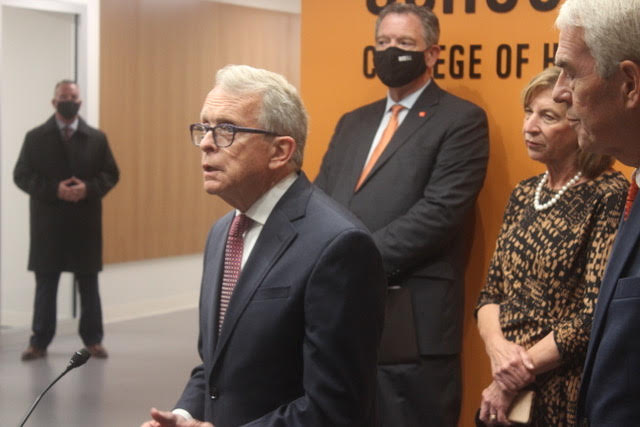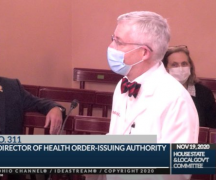BY NICK EVANS
Gov. Mike DeWine is promising a more inclusive and transparent process after the Ohio Supreme Court threw out a pair of new House and Senate maps Wednesday. In an end of year interview with Ohio Capital Journal, DeWine said talks have already begun, and a first meeting could happen Monday.
“The first thing we need to do is to instruct whoever is physically drafting (maps) to follow what our understanding is of what the Supreme Court has said.” DeWine said. “That’s step one, and that will be a public instruction so that it’s on the record everybody sees it everybody knows what the map people are instructed to do.”
The court determined DeWine and other Republicans on the Ohio Redistricting Commission ignored constitutional requirements related to partisanship and proportionality. The court gave the seven-member panel ten days to try again. The opinion lays out in black and white the proportion of seats each party should control based on constitutional guidelines — about 54% for Republicans and 46% for Democrats. Those figures are based on the average outcome of statewide elections over the last 10 years. DeWine says he got the message.
“The court has defined you know, the percentages that we should be aiming at.” DeWine said. “So, until we go into it, it’s not going to be clear whether we can do that and how close we’re able to get, but the court has laid out what we should do and what the criteria is, and I think, we follow that and, and try to try to come up with a map.”
During the commission’s initial deliberations, Democratic members proposed a map that would’ve give Republicans an advantage in line with that 54% share of the electorate. The court opinion notes the map “almost exactly mirrored those percentages,” and that Democrats even came up with small changes that nudged the Republican share higher.
Despite voicing public misgivings at the time, DeWine joined the other GOP commissioners and cast his vote for a plan that created an even larger Republican majority. Even now, after the Supreme Court’s rejection of that map, DeWine doesn’t regret his decision.
“No, I explained why I voted the way I did,” DeWine said. “Frankly, the Republican one fit the criteria as laid out in the Constitution better than the Democrat (one). I had always thought that we’d be able to reach a compromise, and by that night it was clear that neither side was going to move one inch.”
Now, as the commission prepares to try again, DeWine won’t commit to voting for a plan that garners Democratic support — ‘I’m not going to tie my hands,’ he explained — but he does describe a process where all members are involved, and the performance expectations are more clear.
“Last time we had Democrat map, Republican map, I thought we could come to something together. That didn’t work,” DeWine said. “The Supreme Court I think has certainly indicated that all members of the commission need to be involved not just in deciding, but all of them need to be involved in the creation of the map, and so I think you’re going to see all the commissioners involved in some way from the beginning.”
That said, the governor repeatedly hedged in the interview, explaining commissioners would do their best to come up with a map and to meet the court’s deadline.
DeWine is less circumspect when it comes to the question of handing redistricting over to an independent commission. Numerous other states have done so, and while it has not always been perfect, some advocates argue it’s a better approach than handing maps to politicians who have a vested interest.
In a surprising concurrence, Republican Chief Justice Maureen O’Connor argued they’ve got a point.
“Having now seen firsthand that the current Ohio Redistricting Commission—comprised of statewide elected officials and partisan legislators—is seemingly unwilling to put aside partisan concerns as directed by the people’s vote,” O’Connor wrote, “Ohioans may opt to pursue further constitutional amendment to replace the current commission with a truly independent, nonpartisan commission that more effectively distances the redistricting process from partisan politics.”
DeWine argued “we’re not there yet.” With clarity about the court’s expectations, he said, the commission is on a better path — and it should be judged on what it comes up with.
“We ought to look and see how we are able to execute this, and then I think people will be able to judge whether or not there needs to be a constitutional change.”
***
Also from Ohio Capital Journal:
Commentary: About the GOP’s historical amnesia on voting rights
If you get into an argument with a Republican about the GOP’s lamentable support for voting rights and its fractured relationship with Black Americans, it won’t be long before your rhetorical sparring partner bellows “Robert Byrd” at you and declares the argument over.
The logic here, if it even can be called that, is that because Byrd, the wizened former U.S. senator from West Virginia who has been dead for more than a decade, was once a member of the Ku Klux Klan, then Democrats cannot be true supporters of civil rights and Black Americans. This political original sin is further compounded, they will tell you, by the fact that such southern Democrats as the late Arkansas Gov. Orval Fabus led the charge against school desegregation in the late 1950s.
This analysis leaves out the fact that Byrd had a well-documented change of heart later in life, and that the so-called “southern strategy” Richard Nixon and Barry Goldwater employed in the 1960s lured racist whites into the Republican fold, where they have remained ever since.
A half-century later, a Trumpified Republican Party that’s left the legacy of Abraham Lincoln far behind, is still flipping Democrats the Byrd as it stands steadfastly in the way of the voting rights legislation that’s now slowly and torturously making its way through Congress. READ MORE





